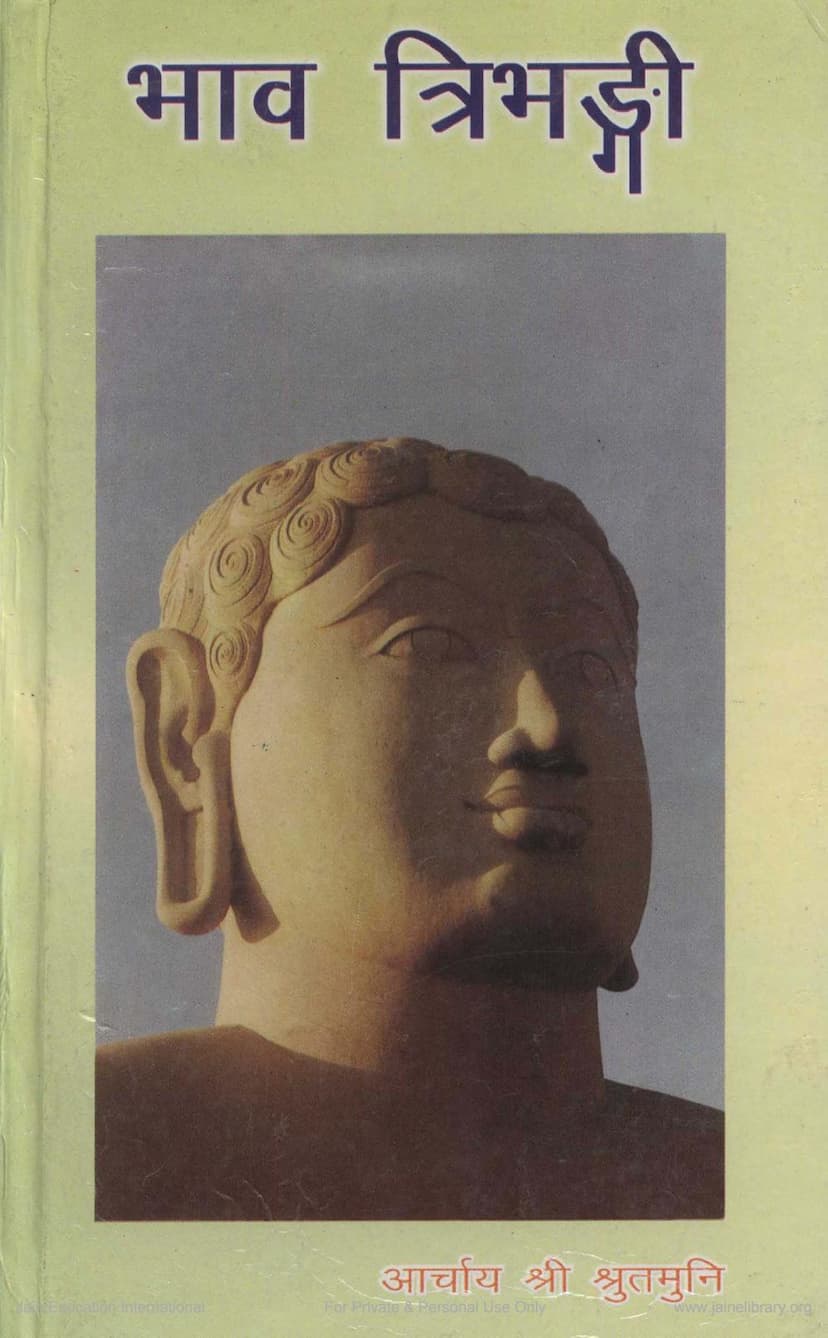Bhav Tribhangi
Added to library: September 1, 2025

Summary
Here's a comprehensive summary of the Jain text "Bhav Tribhangi" (भाव त्रिभङ्गी) by Acharya Shri Shrutmuni, translated and edited by Brahmachari Vinod Jain and Brahmachari Anil Jain, and published by Gangwal Dharmik Trust Raipur:
Overall Purpose and Content:
"Bhav Tribhangi" (भाव त्रिभङ्गी), meaning "Threefold Aspects of States/Emotions," is a Jain philosophical work that meticulously details the various states (Bhavas) of the soul. The book aims to elucidate the nature of these states, their classification, and their manifestation across different stages of spiritual progress (Gunasthans) and life conditions (Marganas). It delves into the intricate workings of karma and its influence on the soul's experiential states.
Key Authors and Publishers:
- Author: Acharya Shri Shrutmuni
- Translation/Editing: Brahmachari Vinod Jain, Brahmachari Anil Jain
- Publisher: Gangwal Dharmik Trust, Raipur (Madhya Pradesh)
- First Edition: May 2000
Core Concepts Explained:
The central theme of the book revolves around the five fundamental Bhavas (states) of the soul:
- Aupashamik Bhava (औपशमिक भाव): States that arise from the pacification (Upasham) of karmic obstructions.
- Kshayik Bhava (क्षायिक भाव): States that arise from the complete destruction (Kshaya) of karmic obstructions.
- Kshayopashamik Bhava (क्षायोपशमिक भाव): States that arise from the partial destruction (Kshaya) and partial pacification (Upasham) of karmic obstructions. This is the most common state experienced by souls.
- Audayik Bhava (औदयिक भाव): States that arise from the fruition (Udaya) of karmas.
- Parinamik Bhava (पारिणामिक भाव): Innate, essential states of the soul that are natural and not dependent on external causes.
The text systematically categorizes these Bhavas, explaining their sub-types and the number of each type (e.g., 9 types of Kshayik Bhava, 2 of Aupashamik, 18 of Kshayopashamik, 21 of Audayik, and 3 of Parinamik).
Detailed Analysis of Bhavas in Gunasthans and Marganas:
A significant portion of the book is dedicated to the "Tribhangi" (त्रिभङ्गी), which refers to the analysis of Bhavas in three aspects:
- Vayucchitti (व्युच्छित्ति): The cessation or disappearance of a particular Bhava.
- Sadbhava (सद्भाव): The presence or existence of a particular Bhava.
- Abhava (अभाव): The absence of a particular Bhava.
The book meticulously maps out which Bhavas are present (Sadbhava), absent (Abhava), and cease (Vayucchitti) in each of the 14 Gunasthans (stages of spiritual development) and various Marganas (life forms and conditions). This includes detailed tables and explanations for:
- Gunasthans: From Mithyatva (delusion) to Sayogi and Ayogi Kevali (omniscient beings).
- Marganas:
- Gati (गति): Naraka (hellish), Tiryancha (animal), Manushya (human), Deva (celestial).
- Indriya (इंद्रिय): One-sensed to five-sensed beings.
- Kaya (काय): Body types (audarik, vaikriyik, ahārak, etc.).
- Yoga (योग): Mind, speech, and body activities.
- Vedha (वेध): Gender (male, female, neuter).
- Kashaya (कषाय): Anger, pride, deceit, greed.
- Jnana (ज्ञान): Types of knowledge (mati, shruta, avadhi, manahparyaya, kevala).
- Darshana (दर्शन): Types of perception (chakshu, achakshu, avadhi, kevala).
- Samyama (संयम): Types of restraint.
- Leshya (लेष्या): Karmic dispositions (Krishna, Neel, Kapot, Teju, Padma, Shukla).
- Bhavya (भव्य): Souls with potential for liberation, and Abhavya (souls without this potential).
- Sanjna (संज्ञा): Sentient beings.
- Aharaka (आहारक): Souls with āhārak body.
- Ahārak (अनाहारक): Souls without āhārak body.
The extensive tabular data (Sandrishti) provides a comprehensive grid of these Bhavas across the Gunasthans and Marganas, highlighting the presence, absence, and cessation of each state.
Special Features and Contributions:
- Elucidation of Subtle Concepts: The book is praised for its detailed and nuanced explanation of the complex theory of Bhavas in Jainism, which is often considered a highly subtle topic.
- Focus on Kshayopashamik and Audayik Bhavas: The text provides in-depth analysis of the Kshayopashamik and Audayik Bhavas, as these are the most prevalent states experienced by living beings.
- Emphasis on "Tribhangi": The unique contribution of the book is its systematic breakdown of Bhavas into their three aspects (Vayucchitti, Sadbhava, Abhava) within each Gunasthan and Margana.
- Clarification of Definitions: The book offers precise definitions and explanations for key terms and concepts related to Bhavas, sometimes presenting novel phrasing for clarity.
- Scholarly Rigor: The translation and editing by Brahmachari Vinod Jain and Anil Jain are acknowledged for their scholarly approach, making the original text accessible to a wider audience.
- Inspiration from Acharya Vidyasagar: The text is mentioned to be inspired by the blessings and guidance of Acharya Shri Vidyasagar Ji Maharaj, highlighting the tradition of knowledge transmission.
- Discussion of Contradictions/Points of Consideration: The editorial section also thoughtfully points out areas of potential scholarly debate or different interpretations found in other texts, demonstrating a balanced approach to the subject matter.
Significance and Target Audience:
"Bhav Tribhangi" is considered an invaluable resource for Jain scholars, monks, nuns, and serious students of Jain philosophy. It provides a structured and comprehensive understanding of the soul's states, essential for comprehending the path to liberation (Moksha). The detailed tables and explanations serve as a reference guide for understanding the spiritual journey and the karmic mechanisms involved.
In essence, "Bhav Tribhangi" is a profound and exhaustive exploration of the subjective experiences of the soul as analyzed through the lens of Jain ontology and karmic theory, making it a cornerstone text for deeper spiritual study.